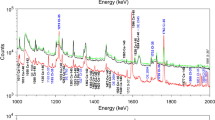Abstract
THE existence of the long-lived radionuclide chlorine-36 in iron meteorites, where it is produced by the spallation of the metal during its exposure to cosmic rays in space, is now well known. The measurements of cosmogenic 36Ar and 36Cl so produced permit one to calculate the so-called cosmic-ray exposure age of a meteorite. In this communication the results of experiments which show that in large iron meteorites the production of this nuclide also takes place via the reaction 35Cl(n,γ)36Cl on the lawrencite inclusions in the metal are presented. This result is of significance in deducing the history of meteorites from the investigation of cosmic-ray reaction products.
Similar content being viewed by others
References
Goel, P. S., Cosmogenic Carbon-14 and Chlorine-36 in Meteorites, thesis Carnegie Institute of Technology, U.S.A.E.C. Rep. NYO–8922 (1962).
Goel, P. S., and Kohman, T. P., Radioactive Dating, Intern. Atomic Energy Agency, Vienna, 413 (1963).
Kaye, J. H., Cosmogenic X-ray and β-ray Emitters in Iron Meteorites, thesis, Carnegie Institute of Technology, U.S.A.E.C., Rep. NYO–8923 (1963); Nuclear Chemistry Research at Carnegie Institute of Technology, 1962–1963, 62 (1963).
Eberhardt, P., Geiss, J., and Lutz, H., Earth Science and Meteoritics, 143 (North-Holland Publishing Company, Amsterdam, 1963).
Author information
Authors and Affiliations
Rights and permissions
About this article
Cite this article
GOEL, P. Chlorine-36 produced by Neutron Capture in Meteorites. Nature 203, 1162–1163 (1964). https://doi.org/10.1038/2031162a0
Issue Date:
DOI: https://doi.org/10.1038/2031162a0
- Springer Nature Limited





